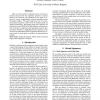2047 search results - page 145 / 410 » The limits of speech recognition |
IJON
1998
13 years 8 months ago
1998
SOM and LVQ algorithms for symbol strings have been introduced and applied to isolatedword recognition, for the construction of an optimal pronunciation dictionary for a given spe...
EMNLP
2010
13 years 7 months ago
2010
This paper focuses on the task of inserting punctuation symbols into transcribed conversational speech texts, without relying on prosodic cues. We investigate limitations associat...
CHI
2004
ACM
14 years 9 months ago
2004
ACM
Editing speech data is currently time-consuming and errorprone. Speech editors rely on acoustic waveform representations, which force users to repeatedly sample the underlying spe...
FGR
2006
IEEE
14 years 3 months ago
2006
IEEE
We present a novel tracking algorithm that uses dynamic programming to determine the path of target objects and that is able to track an arbitrary number of different objects. The...
INTERSPEECH
2010
13 years 3 months ago
2010
Most of current speaker recognition systems are based on features extracted from the magnitude spectrum of speech. However the excitation signal produced by the glottis is expecte...

